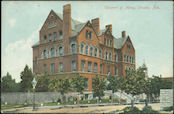Search the Blog
Categories
- Books & Reading
- Broadband Buzz
- Census
- Education & Training
- General
- Grants
- Information Resources
- Library Management
- Nebraska Center for the Book
- Nebraska Libraries on the Web
- Nebraska Memories
- Now hiring @ your library
- Preservation
- Pretty Sweet Tech
- Programming
- Public Library Boards of Trustees
- Public Relations
- Talking Book & Braille Service (TBBS)
- Technology
- Uncategorized
- What's Up Doc / Govdocs
- Youth Services
Archives
Subscribe
Category Archives: Nebraska Memories
Music in Our Schools
It recently came to my attention that March is Music in Our Schools Month, a month dedicated to advocacy in favor of music education programs in schools. If you explore Nebraska Memories, you can see many images of Nebraska’s students enjoying music in their schools.
 Nebraska’s schools provided opportunities for vocal music, as shown in this photograph of the Irving Junior High boys choir in Lincoln. Students also had chances to
Nebraska’s schools provided opportunities for vocal music, as shown in this photograph of the Irving Junior High boys choir in Lincoln. Students also had chances to participate in instrumental music, as shown by the North High School orchestra in Omaha or the band at the Girls’ Industrial School in Geneva.
participate in instrumental music, as shown by the North High School orchestra in Omaha or the band at the Girls’ Industrial School in Geneva.
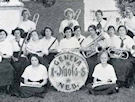 The Polley Music Library collection also includes a number of programs from musical events featuring students. These events include such concerts as those sponsored by the Nebraska Music Teachers Association, as well as Nebraska All State musical concerts.
The Polley Music Library collection also includes a number of programs from musical events featuring students. These events include such concerts as those sponsored by the Nebraska Music Teachers Association, as well as Nebraska All State musical concerts.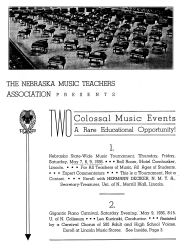
Visit Nebraska Memories to search for or browse through many more historical images digitized from photographs, negatives, postcards, maps, lantern slides, books and other materials.
Nebraska Memories is a cooperative project to digitize Nebraska-related historical and cultural heritage materials and make them available to researchers of all ages via the Internet. Nebraska Memories is brought to you by the Nebraska Library Commission. If your institution is interested in participating in Nebraska Memories, see http://nlc.nebraska.gov/nebraskamemories/participation.aspx for more information, or contact Beth Goble, Government Information Services Director, or Devra Dragos, Technology & Access Services Director.
Taking a Stroll
 … down Memory Lane, er, Main Street. Before suburbs and big box stores, the main street was the heart of many towns. Out on the plains, main streets in many small towns probably began looking something like Crawford’s does in this image from the Crawford Historical Society and Museum Collection. Not enough traffic to keep down the weeds yet, and wooden buildings under construction.
… down Memory Lane, er, Main Street. Before suburbs and big box stores, the main street was the heart of many towns. Out on the plains, main streets in many small towns probably began looking something like Crawford’s does in this image from the Crawford Historical Society and Museum Collection. Not enough traffic to keep down the weeds yet, and wooden buildings under construction.
 In towns that had been established for a little longer, the main streets became hardened dirt—unless there was enough rain to turn it into mud. And while there is still space between the wooden structures on Sacramento’s main street, progress can be seen in the signage on the buildings and the number of people in the picture. Image from the Phelps County Historical Society Collection.
In towns that had been established for a little longer, the main streets became hardened dirt—unless there was enough rain to turn it into mud. And while there is still space between the wooden structures on Sacramento’s main street, progress can be seen in the signage on the buildings and the number of people in the picture. Image from the Phelps County Historical Society Collection.
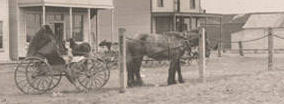 As more businesses and government buildings went up, amenities such as hitching posts became necessary. In this image of Ericson from the Nebraska State Historical Society Collection, between the stores on one side of Main Street and the Post Office on the other a rope has been strung along several posts for wagon parking down the middle of the street. Notice that the buildings are all wooden structures.
As more businesses and government buildings went up, amenities such as hitching posts became necessary. In this image of Ericson from the Nebraska State Historical Society Collection, between the stores on one side of Main Street and the Post Office on the other a rope has been strung along several posts for wagon parking down the middle of the street. Notice that the buildings are all wooden structures.
 Modern inventions like electricity and the telephone brought poles and wires to town. This image of Eagle’s Main Street shows poles down both sides of the street where it looks like paring for wagons and buggies is limited mostly to the west side of the street—or one business is really popular! Note that there is one brick building on the right-side of the street. This image is from the Jane Pope Geske Heritage Room of Nebraska Authors Collection.
Modern inventions like electricity and the telephone brought poles and wires to town. This image of Eagle’s Main Street shows poles down both sides of the street where it looks like paring for wagons and buggies is limited mostly to the west side of the street—or one business is really popular! Note that there is one brick building on the right-side of the street. This image is from the Jane Pope Geske Heritage Room of Nebraska Authors Collection.
 By the 1930s most poles and lines have been banished to the alleys. And as seen on Fairmont’s Main Street, street lights have been installed in front of brick buildings. Hitching posts have disappeared and no parking meters have appeared as yet in this image from the Fairmont Public Library/Fillmore County Historical Society Collection.
By the 1930s most poles and lines have been banished to the alleys. And as seen on Fairmont’s Main Street, street lights have been installed in front of brick buildings. Hitching posts have disappeared and no parking meters have appeared as yet in this image from the Fairmont Public Library/Fillmore County Historical Society Collection.
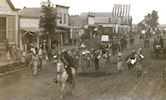 And over the years, big events in town took place on Main Street, like Fourth of July parades, political speeches, and the Calathumpian Parade shown here in Fremont. This image is part of the Keene Memorial Library Collection.
And over the years, big events in town took place on Main Street, like Fourth of July parades, political speeches, and the Calathumpian Parade shown here in Fremont. This image is part of the Keene Memorial Library Collection.
Visit Nebraska Memories to search for or browse through many more historical images digitized from photographs, negatives, postcards, maps, lantern slides, books and other materials.
Nebraska Memories is a cooperative project to digitize Nebraska-related historical and cultural heritage materials and make them available to researchers of all ages via the Internet. Nebraska Memories is brought to you by the Nebraska Library Commission. If your institution is interested in participating in Nebraska Memories, see http://nlc.nebraska.gov/nebraskamemories/participation.aspx for more information, or contact Beth Goble, Government Information Services Director, or Devra Dragos, Technology & Access Services Director.
Helping the Children
It’s nice when different projects we work on at the Library Commission come together in some way. In this case some biennial reports that we have scanned from our state documents collection are related to a new Nebraska Memories participant.
The Nebraska Children’s Home Society has a long history of caring for children who have been orphaned or become wards of the state. The Society recently contributed images of some of their historical photographs to Nebraska Memories. Dr. Elmer P. Quivey founded the Nebraska Children’s Home Society in 1893 and was the State Superintendent from 1893 to 1920. The Society offered support and assistance to parents committed to keeping their family together, and provided foster and adoptive homes for children who could not stay with their families. It also worked to find homes for children admitted to the state Home for the Friendless. The 1904 Biennial Report of the Home for the Friendless provides a wealth of information about the education, nutrition, health and placement of children who lived there.
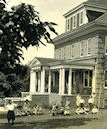 In 1923 the Nebraska Children’s Home Society constructed a building at 3549 Fontenelle Boulevard in Omaha. It was a residence for children awaiting adoption as well as the Society headquarters. In this photo a badminton game is being played on the lawn by two boys, while other children watch. I love the bloomer style pants one of the players is wearing! Additions were made to the building in 1948 and 1965.
In 1923 the Nebraska Children’s Home Society constructed a building at 3549 Fontenelle Boulevard in Omaha. It was a residence for children awaiting adoption as well as the Society headquarters. In this photo a badminton game is being played on the lawn by two boys, while other children watch. I love the bloomer style pants one of the players is wearing! Additions were made to the building in 1948 and 1965.

 These fellows are obviously having a great time as toymakers in training. Were the toys being made for younger children at the home, for them to play with, or perhaps to sell to support the Home? They were gaining skills in the shop that would have been helpful for future employment.
These fellows are obviously having a great time as toymakers in training. Were the toys being made for younger children at the home, for them to play with, or perhaps to sell to support the Home? They were gaining skills in the shop that would have been helpful for future employment.
 These girls were gaining other skills – in the domestic arts – while baking a cake. Do you think the boys ever got to help with the cooking or the girls ever got to work in the shop?
These girls were gaining other skills – in the domestic arts – while baking a cake. Do you think the boys ever got to help with the cooking or the girls ever got to work in the shop?
Visit Nebraska Memories to search for or browse through many more historical images digitized from photographs, negatives, postcards, maps, lantern slides, books and other materials.
Nebraska Memories is a cooperative project to digitize Nebraska-related historical and cultural heritage materials and make them available to researchers of all ages via the Internet. Nebraska Memories is brought to you by the Nebraska Library Commission. If your institution is interested in participating in Nebraska Memories, see http://nlc.nebraska.gov/nebraskamemories/participation.aspx for more information, or contact Beth Goble, Government Information Services Director, or Devra Dragos, Technology & Access Services Director.
Posted in General, Nebraska Memories
Leave a comment
Don’t Forget the Back
When looking at old postcards it’s easy to get fixated on the image on the front of the postcard or pass a postcard by because the image doesn’t capture your attention. I think it’s important to take a minute and look at the back of the postcard. If you are lucky it will be a used postcard. Let me show you some used postcards in Nebraska Memories that have some interesting backs.
Let’s start with this postcard of the Omaha High School, Omaha, Neb. It is an interesting picture of the High School but I find the back to be pretty amusing. I wish I knew more about Margaret, Cheaty and Helen.
“Der Elsa: How would you like to go to this High School. It certainly is a whopper. Cheaty aught to teach here. Ha!Ha! I could go and see him real often. (Would he like it) and have Helen in my hair. Write and tell me the news.
Margaret Paisch 1041 – 1 ave. So.”
Before moving on I wanted to point out that luckily we don’t have to read the handwriting on the back of these cards. The text from the postcard can be found in the Transcript field which is located on the Item Description area.
The text on the back of the Convent of Mercy postcard is pretty short. It reminds me of a message that I’d actually send as a text message.
Will drop you a line to let you know Pappa & Mamma & Kruses are coming over to see you Sunday. Seems as if your papper never will come.
They will be their Sunday for dinner.
Love from all. your Sis Dora”
There are too many postcard backs I like for me to share them word for word. Here are a few teasers and links so you can read the complete transcript if you want to know more.
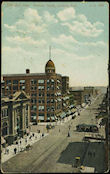 “Say don’t you wish you could tell me something over telephone? HaHa” This card is postmarked 1911. I wonder when telephones became conman in Nebraska and Kansas.
“Say don’t you wish you could tell me something over telephone? HaHa” This card is postmarked 1911. I wonder when telephones became conman in Nebraska and Kansas.- Here is another one that reminds me of a text message. How would you like to revive a postcard reminding you to do the dishes?
- This next postcard is from SMD telling Isabelle that “No I haven’t got a girl yet. Honest.”
- We know the X on the right side of this post card is where John lives.
- (Don’t tell ma) we are here. I wonder if here is the St. Philomena Catholic Church or here is Omaha.
- Emma is mailing her shopping list. She would like them to “buy fresh yeast 15 cents worth”. She’s very persistent: “15 cents worth. don’t forget.”.
- Would you go see Bessie after her talk of Scarlet fever?
Visit Nebraska Memories to search for or browse through many more historical images digitized from photographs, negatives, postcards, maps, lantern slides, books and other materials.
Nebraska Memories is a cooperative project to digitize Nebraska-related historical and cultural heritage materials and make them available to researchers of all ages via the Internet. Nebraska Memories is brought to you by the Nebraska Library Commission. If your institution is interested in participating in Nebraska Memories, see http://nlc.nebraska.gov/nebraskamemories/participation.aspx for more information, or contact Beth Goble, Government Information Services Director, or Devra Dragos, Technology & Access Services Director.
Posted in General, Nebraska Memories, Technology
Leave a comment
Four-Star Accommodations
If you traveled during the holiday season this year, perhaps your home-away-from-home was a hotel. Compare your experiences to these images of hotels from Nebraska Memories.
 Hotels in Nebraska have ranged from imposing structures, like the Blackstone Hotel in Omaha or the Ruwe Hotel in Fremont, to smaller establishments, like Wilcox House in Papillion or the Talbot Hotel in Brainard.
Hotels in Nebraska have ranged from imposing structures, like the Blackstone Hotel in Omaha or the Ruwe Hotel in Fremont, to smaller establishments, like Wilcox House in Papillion or the Talbot Hotel in Brainard.
Nebraska Memories features views of the interiors of hotels as well. Take a glimpse inside 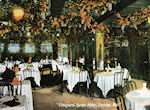 some hotel lobbies, like those at the Hotel Loyal in Omaha or the Perkins Hotel in David City. Some hotels had places to eat inside, like the Vineyard Cafe at the Rome Hotel in Omaha, or the dining room at the Zeeck Hotel in Papillion.
some hotel lobbies, like those at the Hotel Loyal in Omaha or the Perkins Hotel in David City. Some hotels had places to eat inside, like the Vineyard Cafe at the Rome Hotel in Omaha, or the dining room at the Zeeck Hotel in Papillion.
If motels and motor courts are more your style, check out the ![]() Lone Pine Court and Filling Station or Sunnyside Cottages, both located in Sidney.
Lone Pine Court and Filling Station or Sunnyside Cottages, both located in Sidney.
Visit Nebraska Memories to search for or browse through many more historical images digitized from photographs, negatives, postcards, maps, lantern slides, books and other materials.
Nebraska Memories is a cooperative project to digitize Nebraska-related historical and cultural heritage materials and make them available to researchers of all ages via the Internet. Nebraska Memories is brought to you by the Nebraska Library Commission. If your institution is interested in participating in Nebraska Memories, see http://nlc.nebraska.gov/nebraskamemories/participation.aspx for more information, or contact Beth Goble, Government Information Services Director, or Devra Dragos, Technology & Access Services Director.
Say Cheese
I spent a bit of time over the holiday weekend telling family members to smile and say cheese. As usual some of them were more cooperative then others. The other day, as I was looking at the photos I took, I wondered if there were any interesting Christmas photos in Nebraska Memories and I’m happy to report I wasn’t disappointed. Here are a few of my favorites.
 My favorite Christmas picture has to be the photo titled “Family by Christmas tree“. Unfortunately we don’t know the name of the family featured in this photo from the early 1900’s but the looks on their faces are priceless. As the description states none of the six people in the photo are looking in the same direction. In some ways it is a typical family photo however with two of the boys messing around, the third one facing the wrong direction and the fourth one looking very unhappy. Thankfully I don’t think any of my family photos turned out quite this bad. The lack of names on this photo however does serve as a good reminder. I need to take the time to add names to all of my family photos so a hundred plus years from now folks will know the names of everyone in the photo including the person who was making bunny ears.
My favorite Christmas picture has to be the photo titled “Family by Christmas tree“. Unfortunately we don’t know the name of the family featured in this photo from the early 1900’s but the looks on their faces are priceless. As the description states none of the six people in the photo are looking in the same direction. In some ways it is a typical family photo however with two of the boys messing around, the third one facing the wrong direction and the fourth one looking very unhappy. Thankfully I don’t think any of my family photos turned out quite this bad. The lack of names on this photo however does serve as a good reminder. I need to take the time to add names to all of my family photos so a hundred plus years from now folks will know the names of everyone in the photo including the person who was making bunny ears.
 I really have to admire the photographer, children and anyone who helped with this photo of the “Immanuel Children’s Home at Christmas“. Somehow they managed to get eight small children to sit facing the camera, have fairly happy looks on their faces, stop playing with their toys, and hold still long enough to snap a photo. I find that pretty impressive! It’s also a cute picture.
I really have to admire the photographer, children and anyone who helped with this photo of the “Immanuel Children’s Home at Christmas“. Somehow they managed to get eight small children to sit facing the camera, have fairly happy looks on their faces, stop playing with their toys, and hold still long enough to snap a photo. I find that pretty impressive! It’s also a cute picture.
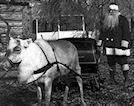 I also enjoyed looking at all of the Christmas trees in the different photos. Some of them are pretty scraggly compared to the artificial trees I’m used to seeing today. And finally what would a set of Christmas pictures be without a picture of Santa Claus with his sleigh and reindeer.
I also enjoyed looking at all of the Christmas trees in the different photos. Some of them are pretty scraggly compared to the artificial trees I’m used to seeing today. And finally what would a set of Christmas pictures be without a picture of Santa Claus with his sleigh and reindeer.
Visit Nebraska Memories to search for or browse through many more historical images digitized from photographs, negatives, postcards, maps, lantern slides, books and other materials.
Nebraska Memories is a cooperative project to digitize Nebraska-related historical and cultural heritage materials and make them available to researchers of all ages via the Internet. Nebraska Memories is brought to you by the Nebraska Library Commission. If your institution is interested in participating in Nebraska Memories, see http://nlc.nebraska.gov/nebraskamemories/participation.aspx for more information, or contact Beth Goble, Government Information Services Director, or Devra Dragos, Technology & Access Services Director.
The Weather Outside is Frightful
Oh the weather outside is frightful,
But the fire is so delightful,
And since we’ve no place to go,
Let It Snow! Let It Snow! Let It Snow!
I love this song, created by lyricist Sammy Cahn and composer Jule Styne in 1945. Today is the official first day of winter, but we know that in Nebraska snow usually arrives earlier at least somewhere in the state. The song is about staying inside while it snows, but we have lots of examples in Nebraska Memories of people being OUTSIDE to play or work in the snow. 
This 1940 image of Children and adults by a truck shows 13 kids packed into the back of a truck for a ride sponsored by the Dundee Kiwanis Club. The four women are dressed in the long coats and skirts typical of that era, plus a lone gentleman who was probably the driver. No seatbelts in those days!
The Dundee Kiwanis Club also flooded part of their playground in the winter to make an outdoor rink for ice skating . I fondly remember the outdoor rink at my neighborhood community league playground in Edmonton, Alberta, where I grew up. The boys played hockey and the girls took figure skating lessons. How times have changed – now girls get to play hockey too!
 Adults also liked to have fun in the snow, like this group of students having a snowball fight at Union College in the first decade of the 20th century. Do you wonder if the young man dropping the snowball on the head of the young woman next to him was trying to get her attention for other reasons?
Adults also liked to have fun in the snow, like this group of students having a snowball fight at Union College in the first decade of the 20th century. Do you wonder if the young man dropping the snowball on the head of the young woman next to him was trying to get her attention for other reasons?
But work has to be done no matter what the weather is like . Livestock still needs feeding and somebody has to keep the wheels turning, like Engineer G. Strayer driving a train through snow following a blizzard in southwest Nebraska in the late 1940’s.
Visit Nebraska Memories to search for or browse through many more historical images digitized from photographs, negatives, postcards, maps, lantern slides, books and other materials.
Nebraska Memories is a cooperative project to digitize Nebraska-related historical and cultural heritage materials and make them available to researchers of all ages via the Internet. Nebraska Memories is brought to you by the Nebraska Library Commission. If your institution is interested in participating in Nebraska Memories, see http://nlc.nebraska.gov/nebraskamemories/participation.aspx for more information, or contact Beth Goble, Government Information Services Director, or Devra Dragos, Technology & Access Services Director.
Posted in General, Information Resources, Nebraska Memories
Leave a comment
To Top It Off
Hats, bonnets (sun, poke, cottage, drawn), caps, berets, turbans, wimples, fascinators, hoods, pillboxes, boaters, cloches, bandeaux, chapeaux … warmth, protection or fashion statement?
Few women in Nebraska wear hats on a regular basis anymore, unless they belong to a special group. However, it used to be that women wouldn’t be seen out in public without one. While many women’s head coverings may have been worn to keep the head warm or protect the face from the sun, there were more reasons for wearing them.

 Some head coverings represent a profession or calling. Evelyn Powell is pictured in a US Naval Reserve (Women’s Reserve) uniform in the last year of World War II. [These women were also known as WAVES which stood for Women Accepted for Volunteer Emergency Service.] Emily Anderson wears the cap symbolic of the nursing profession. These and the portrait images in this post are from the Butler County Gallery Collection.
Some head coverings represent a profession or calling. Evelyn Powell is pictured in a US Naval Reserve (Women’s Reserve) uniform in the last year of World War II. [These women were also known as WAVES which stood for Women Accepted for Volunteer Emergency Service.] Emily Anderson wears the cap symbolic of the nursing profession. These and the portrait images in this post are from the Butler County Gallery Collection.

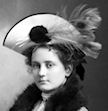 But outside of the professional use, many hats were definitely worn as a fashion statement. Birds and their feathers were popular for decorations, making some hats pure flights of fancy. The hat to the left, worn by Dana Fenlon, has full wings to takeoff. Others, like the one worn by Bertha Neal at right, limited themselves to a few feathers.
But outside of the professional use, many hats were definitely worn as a fashion statement. Birds and their feathers were popular for decorations, making some hats pure flights of fancy. The hat to the left, worn by Dana Fenlon, has full wings to takeoff. Others, like the one worn by Bertha Neal at right, limited themselves to a few feathers.
 Flowers and bows were also popular. Hazel Walker’s hat is limited to blossoms. Other decorations abound on the many women’s hats found in the images of Nebraska Memories. And, for those who needed help in making a statement,
Flowers and bows were also popular. Hazel Walker’s hat is limited to blossoms. Other decorations abound on the many women’s hats found in the images of Nebraska Memories. And, for those who needed help in making a statement,  there was great fun in trying on the latest creations in the millinery department of the local store, such as the one in the Nebraska Clothing Company.
there was great fun in trying on the latest creations in the millinery department of the local store, such as the one in the Nebraska Clothing Company.
Visit Nebraska Memories to search for or browse through many more historical images digitized from photographs, negatives, postcards, maps, lantern slides, books and other materials.
Nebraska Memories is a cooperative project to digitize Nebraska-related historical and cultural heritage materials and make them available to researchers of all ages via the Internet. Nebraska Memories is brought to you by the Nebraska Library Commission. If your institution is interested in participating in Nebraska Memories, see http://nlc.nebraska.gov/nebraskamemories/participation.aspx for more information, or contact Beth Goble, Government Information Services Director, or Devra Dragos, Technology & Access Services Director.
Posted in General, Information Resources, Nebraska Memories
Leave a comment
Life at Camp Atlanta
Today is the 70th anniversary of the attack on Pearl Harbor, which led to the entry of the United States into World War II. Some interesting World War II-era photographs in  Nebraska Memories show Camp Atlanta, a prisoner of war camp for German soldiers that was located outside of Atlanta, Nebraska, near Holdrege. Construction began on
Nebraska Memories show Camp Atlanta, a prisoner of war camp for German soldiers that was located outside of Atlanta, Nebraska, near Holdrege. Construction began on the camp in September of 1943, and it was in operation until 1946, eventually housing 3,000 German prisoners.
the camp in September of 1943, and it was in operation until 1946, eventually housing 3,000 German prisoners.
The images of Camp Atlanta, part of the Phelps County Historical Society  collection, give a good overview of daily life at the camp. The German POWs served as cooks and firefighters for the camp. Some even took part in theatrical
collection, give a good overview of daily life at the camp. The German POWs served as cooks and firefighters for the camp. Some even took part in theatrical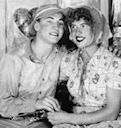 productions.
productions.
Visit Nebraska Memories to search for or browse through many more historical images digitized from photographs, negatives, postcards, maps, lantern slides, books and other materials.
Nebraska Memories is a cooperative project to digitize Nebraska-related historical and cultural heritage materials and make them available to researchers of all ages via the Internet. Nebraska Memories is brought to you by the Nebraska Library Commission. If your institution is interested in participating in Nebraska Memories, see http://nlc.nebraska.gov/nebraskamemories/participation.aspx for more information, or contact Beth Goble, Government Information Services Director, or Devra Dragos, Technology & Access Services Director.
Fitting the Tilden Community Story into American History
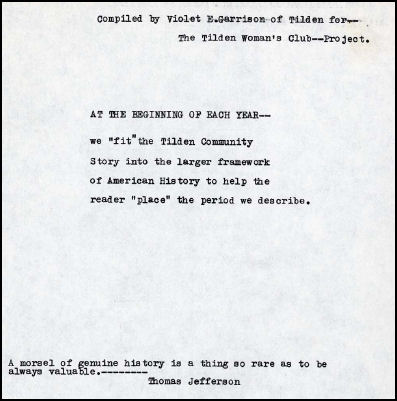 Last week I had the opportunity to drive through Tilden NE. For those of you not familiar with Tilden it is located about 20 miles west of Norfolk on highway 275 along the Elkhorn River. As I drove through town I thought about the “Tilden Woman’s Club project of local historical remembrance” that can be found in Nebraska Memories.
Last week I had the opportunity to drive through Tilden NE. For those of you not familiar with Tilden it is located about 20 miles west of Norfolk on highway 275 along the Elkhorn River. As I drove through town I thought about the “Tilden Woman’s Club project of local historical remembrance” that can be found in Nebraska Memories.
This 120+ page type-written manuscript with hand-written corrections was compiled by Violet E. Garrison of Tilden for the Tilden Woman’s Club project. It covers the history of Tilden, which was originally named Burnett, from 1870 to 1902. The paragraph on the front cover of the document states: “At the beginning of each year–we “fit” the Tilden Community Story into the larger framework of American history to help the reader “place” the period we describe.”
The document is very interesting to read. It paints a great picture of what life in Nebraska was like in the late 1800’s. I can only imagine what the land looked like back then with buffalo, antelope, elk, deer, beaver, wolves, badgers and wild cats roaming the land.
I knew that Tilden currently is located in both Madison and Antelope County, but I didn’t realize this divide dated back to at least 1885. The Village of Burnett was incorporated in 1885. There was one small problem however; the first corporate limits did not include any territory in Antelope County. This split in 1885 left about 1/3 of the population free from city tax and not controlled by city ordinances. “This situation was novel in that public peace could be disturbed on the Antelope side of Tilden, and those offending could not be arrested by the Burnett Marshal under city laws.” “This condition was to prevail until 1894 when the Antelope side of Tilden was annexed.”
To learn more about the history of Tilden and Nebraska in the late 1800’s spend some time reading the “Tilden Woman’s Club project of local historical remembrance”.
Visit Nebraska Memories to search for or browse through many more historical images digitized from photographs, negatives, postcards, maps, lantern slides, books and other materials.
Nebraska Memories is a cooperative project to digitize Nebraska-related historical and cultural heritage materials and make them available to researchers of all ages via the Internet. Nebraska Memories is brought to you by the Nebraska Library Commission. If your institution is interested in participating in Nebraska Memories, see http://nlc.nebraska.gov/nebraskamemories/participation.aspx for more information, or contact Beth Goble, Government Information Services Director, or Devra Dragos, Technology & Access Services Director.
Posted in General, Information Resources, Nebraska Memories, Technology
1 Comment
Veterans of World War I
This Friday is Veterans Day, which is observed as a holiday to honor veterans who served in all wars. However, the holiday has only been called Veterans Day in the United States since 1954. It originally began as Armistice Day, in honor of the armistice that ended World War I on November 11, 1918, as a way of honoring the veterans of that war.
 Nebraska Memories includes a few photographs of soldiers in World War I era military uniforms, including these Student
Nebraska Memories includes a few photographs of soldiers in World War I era military uniforms, including these Student  Army Training Corps members at Wayne State College. Another Nebraskan, Clyde Zeilinger of David City, served as a medic during World War I and was held as a prisoner of war in Germany for two weeks. He is pictured in Nebraska Memories in his military uniform.
Army Training Corps members at Wayne State College. Another Nebraskan, Clyde Zeilinger of David City, served as a medic during World War I and was held as a prisoner of war in Germany for two weeks. He is pictured in Nebraska Memories in his military uniform.
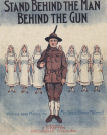 Perhaps the most interesting World War I items in Nebraska Memories are several pieces of sheet music for songs written during the war, all part of the Polley Music Library collection. Many of these songs exhort Americans at home to do their part to support those serving overseas, such as “Stand Behind the Man Behind the Gun.” While all of these
Perhaps the most interesting World War I items in Nebraska Memories are several pieces of sheet music for songs written during the war, all part of the Polley Music Library collection. Many of these songs exhort Americans at home to do their part to support those serving overseas, such as “Stand Behind the Man Behind the Gun.” While all of these 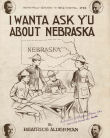 songs were written by Nebraskans, one song in particular (“I Wanta Ask Y’u About Nebraska”) is about two Nebraskan soldiers fighting overseas during the war, reminiscing about home. One interesting note: You’ll notice that the lyrics of both of these songs refer to American soldiers as “Sammies.” This was a nickname for American troops during World War I, a reference to Uncle Sam.
songs were written by Nebraskans, one song in particular (“I Wanta Ask Y’u About Nebraska”) is about two Nebraskan soldiers fighting overseas during the war, reminiscing about home. One interesting note: You’ll notice that the lyrics of both of these songs refer to American soldiers as “Sammies.” This was a nickname for American troops during World War I, a reference to Uncle Sam.
Visit Nebraska Memories to search for or browse through many more historical images digitized from photographs, negatives, postcards, maps, lantern slides, books and other materials.
Nebraska Memories is a cooperative project to digitize Nebraska-related historical and cultural heritage materials and make them available to researchers of all ages via the Internet. Nebraska Memories is brought to you by the Nebraska Library Commission. If your institution is interested in participating in Nebraska Memories, see
http://nlc.nebraska.gov/nebraskamemories/participation.aspx for more information, or contact Beth Goble, Government Information Services Director, or Devra Dragos, Technology & Access Services Director.
Posted in General, Information Resources, Nebraska Memories, Technology
1 Comment
Celebrating Native American Heritage
 November is Native American Heritage Month, and this week we are highlighting a collection of photographs taken by John Alvin Anderson . The images were contributed to Nebraska Memories by the Nebraska State Historical Society, which scanned part of its collection of Anderson’s glass plate negatives. John A. Anderson was born in Sweden in 1869 and brought to Pennsylvania with his family in 1870. In 1883 he came to Cherry County with his father and brothers. He learned photography at an early age and took photographs of soldiers and natives living at Fort Niobrara and the Rosebud Reservation in South Dakota. In 1889 he was the official photographer for the Crook Treaty Council held by General George Crook with the Brule Sioux at the Rosebud Reservation.
November is Native American Heritage Month, and this week we are highlighting a collection of photographs taken by John Alvin Anderson . The images were contributed to Nebraska Memories by the Nebraska State Historical Society, which scanned part of its collection of Anderson’s glass plate negatives. John A. Anderson was born in Sweden in 1869 and brought to Pennsylvania with his family in 1870. In 1883 he came to Cherry County with his father and brothers. He learned photography at an early age and took photographs of soldiers and natives living at Fort Niobrara and the Rosebud Reservation in South Dakota. In 1889 he was the official photographer for the Crook Treaty Council held by General George Crook with the Brule Sioux at the Rosebud Reservation.

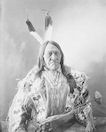 In 1895 Anderson married and moved to the Reservation with his wife, where he opened a store and continued to photograph the people living there. He was able to photograph several chiefs, including this 1902 one of Chief Two Strike , who was a member of a delegation to Washington, D.C. after the Wounded Knee Massacre in 1890. He also took many photos of daily activities like cattle branding and butchering and of festivities like the Grass Dance pictured at the top of this posting, which is still danced today .
In 1895 Anderson married and moved to the Reservation with his wife, where he opened a store and continued to photograph the people living there. He was able to photograph several chiefs, including this 1902 one of Chief Two Strike , who was a member of a delegation to Washington, D.C. after the Wounded Knee Massacre in 1890. He also took many photos of daily activities like cattle branding and butchering and of festivities like the Grass Dance pictured at the top of this posting, which is still danced today .
Setting aside a time to honor Native Americans has been advocated for many years, and some states have done this. Although an official national holiday has never been enacted, in 1990 Congress passed a resolution designating November as National American Indian Heritage Month. The designation has been renewed each year since 1994. The Library of Congress, National Archives and Records Administration, National Endowment for the Humanities, National Gallery of Art, National Park Service, Smithsonian Institution and United States Holocaust Memorial Museum host the Native American Heritage Month website linking to collections, images, audio, video and teacher guides documenting native history and traditions.
Visit Nebraska Memories to search for or browse through many more historical images digitized from photographs, negatives, postcards, maps, lantern slides, books and other materials. Nebraska Memories is a cooperative project to digitize Nebraska-related historical and cultural heritage materials and make them available to researchers of all ages via the Internet. Nebraska Memories is brought to you by the Nebraska Library Commission. If your institution is interested in participating in Nebraska Memories, see http://nlc.nebraska.gov/nebraskamemories/participation.aspx for more information, or contact Beth Goble, Government Information Services Director, or Devra Dragos, Technology & Access Services Director.
Tell it to the Judge
We had an interesting situation at the Library Commission this month when two of our staff members were called to serve on a jury the same week as the NLA/NEMA library conference. One ended before it began (mistrial) and the other only lasted a few days. I served on a jury years ago and actually enjoyed the experience. Despite the temporary interruption of my normal activities, I found it fascinating – jury selection, attorney questioning to “winnow” the jury pool, testimony, deliberation, and a visit from the judge after it was over to tell us he thought we “got it right” (whew!). Pondering these legal affairs got me wondering what images relating to trials and courts we have in Nebraska Memories.
Several participants have contributed photos of county or federal courthouses, sometimes several buildings over a span of years. They were important centers of government, and are still the primary government buildings in many Nebraska communities. Some had very modest beginnings.
The first Cheyenne County Courthouse
was originally Suttler’s Store at Fort Sidney. 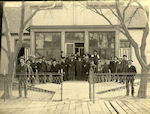
The front porch was a convenient place
for local dignitaries to gather and have their picture taken.
 The next courthouse was a much grander affair that also served as a backdrop for this famous Nebraska politician to be photographed while on the stump. It remained standing until a new courthouse was built around it in 1968.
The next courthouse was a much grander affair that also served as a backdrop for this famous Nebraska politician to be photographed while on the stump. It remained standing until a new courthouse was built around it in 1968.
Some cases go all the way to the top. This photo from the Townsend Studio collection shows the seven men serving as Nebraska Supreme Court Judges in 1921. The first female Supreme Court judge, Lindsey Miller-Lerman, was appointed in 2006. Photos of the current Supreme Court chambers and justices can be viewed on the Nebraska Judicial Branch website.
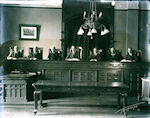 More images of Nebraska courthouses can be viewed here.
More images of Nebraska courthouses can be viewed here.
Visit Nebraska Memories to search for or browse through many more historical images digitized from photographs, negatives, postcards, maps, lantern slides, books and other materials. Nebraska Memories is a cooperative project to digitize Nebraska-related historical and cultural heritage materials and make them available to researchers of all ages via the Internet. Nebraska Memories is brought to you by the Nebraska Library Commission. If your institution is interested in participating in Nebraska Memories, see http://nlc.nebraska.gov/nebraskamemories/participation.aspx for more information, or contact Beth Goble, Government Information Services Director, or Devra Dragos, Technology & Access Services Director.
Posted in General, Nebraska Memories, Technology
Leave a comment
Fighting Fires
Fire fighters were a part of Nebraska’s history even before statehood. The volunteer fire department in Nebraska City, founded in 1856, is the oldest fire department still in existence in the state. While we don’t have any images of the Nebraska City department, Nebraska Memories does include many images of fire fighters from around the state.
 There are quite a few posed pictures of fire fighters, including the 1910-1911 Crawford fire department, the Bertrand fire department sometime around 1900, and some Lincoln fire fighters in 1898.
There are quite a few posed pictures of fire fighters, including the 1910-1911 Crawford fire department, the Bertrand fire department sometime around 1900, and some Lincoln fire fighters in 1898.
If you would like to see fire fighters in action, check out this series of photographs of 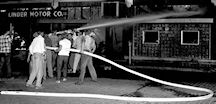 Holdrege volunteer fire fighters battling a fire at Linder Motor Company in 1954. There are also several photographs of the destruction caused by this particular
Holdrege volunteer fire fighters battling a fire at Linder Motor Company in 1954. There are also several photographs of the destruction caused by this particular 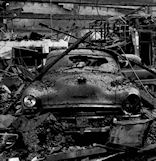 fire.
fire.
Visit Nebraska Memories to search for or browse through many more historical images digitized from photographs, negatives, postcards, maps, lantern slides, books and other materials.
Nebraska Memories is a cooperative project to digitize Nebraska-related historical and cultural heritage materials and make them available to researchers of all ages via the Internet. Nebraska Memories is brought to you by the Nebraska Library Commission. If your institution is interested in participating in Nebraska Memories, see http://nlc.nebraska.gov/nebraskamemories/participation.aspx for more information, or contact Beth Goble, Government Information Services Director, or Devra Dragos, Technology & Access Services Director.
The Burlington Station
Yesterday evening I had the pleasure of attending an event at The Durham Museum in Omaha. If you are not familiar with the museum it’s located in the historic Union Railroad Station. Construction of the station started in 1929 and was officially dedicated on January 15, 1931. In 1975 the Union Station was turned into a museum and received a $22 million renovation in 1995. If you haven’t visited The Durham I’d highly recommend. The building is beautiful and the exhibits are interesting.
 When you are in The Durham you can look out across the railroad tracks and see the Burlington Railroad Station. Unfortunately the Burlington Station has not received the same care and renovation as the Union Station however it does have an interesting history.
When you are in The Durham you can look out across the railroad tracks and see the Burlington Railroad Station. Unfortunately the Burlington Station has not received the same care and renovation as the Union Station however it does have an interesting history.
The Burlington Station was completed in time for the 1898 Tran-Mississippi Expo. The $350,000 Indiana limestone structure originally had 28 columns on the 10th street entrance. Each of the columns weighs approximately 18,000 pounds. The original interior included a double spiral stairway in the center of the second floor. As you can see from the images of the Burlington Station in Nebraska Memories it was a very interesting looking building.
The original interior included a double spiral stairway in the center of the second floor. As you can see from the images of the Burlington Station in Nebraska Memories it was a very interesting looking building.
In 1930 the Burlington Station underwent a $1 million renovation. I’m guessing this renovation was done at this time to compete with the new Union Station being built across the tracks. As part of this renovation the columns were removed giving the station a more classical style. The columns however ended up on the University of Nebraska Lincoln campus near Memorial Stadium. As you can see from the picture I took last night Union Station looks much different with the columns removed.
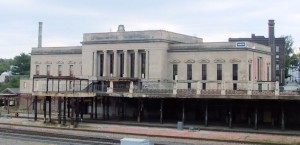 Union Station closed in 1971 and to the best of my knowledge remains vacant.
Union Station closed in 1971 and to the best of my knowledge remains vacant.
Visit Nebraska Memories to search for or browse through many more historical images digitized from photographs, negatives, postcards, maps, lantern slides, books and other materials.
Nebraska Memories is a cooperative project to digitize Nebraska-related historical and cultural heritage materials and make them available to researchers of all ages via the Internet. Nebraska Memories is brought to you by the Nebraska Library Commission. If your institution is interested in participating in Nebraska Memories, see http://nlc.nebraska.gov/nebraskamemories/participation.aspx for more information, or contact Beth Goble, Government Information Services Director, or Devra Dragos, Technology & Access Services Director.
Update: In 2013, KETV NewsWatch 7 purchased the Burlington Station and renovated the building to use as their broadcast facility.
Posted in General, Nebraska Memories, Technology
1 Comment
Motoring On
On September 27, 1908, the first Ford Model T left the factory. Henry Ford’s Model T changed the transportation industry by supplying affordable cars to everyone at $850 per car as opposed to $1,000-$2,000 from other manufacturers. Ford accomplished this by developing assembly line manufacturing which speeded up production and, in turn, helped lower prices.
 Nebraskans were no different than the rest of the world when it came to an interest in automobiles. A number of them tried their hand at designing and/or building their own motor vehicles. Some were big and bulky as you can see in this image of the M.H. Miller vehicle, from the Townsend Collection.
Nebraskans were no different than the rest of the world when it came to an interest in automobiles. A number of them tried their hand at designing and/or building their own motor vehicles. Some were big and bulky as you can see in this image of the M.H. Miller vehicle, from the Townsend Collection.
Others were sleek  and racy, such as the car shown in these images with just its chassis and then the completed vehicle in front of Central Auto
and racy, such as the car shown in these images with just its chassis and then the completed vehicle in front of Central Auto Repair and Machine Works from the Townsend Collection. In addition, to manufacturing companies and auto repair shops, other automobile-related businesses opened, too, such as dealerships, services stations, automobile associations, etc.
Repair and Machine Works from the Townsend Collection. In addition, to manufacturing companies and auto repair shops, other automobile-related businesses opened, too, such as dealerships, services stations, automobile associations, etc.
 W.L Huffman Auto Company was one of many car dealerships that sprang up around the state to sell these new machines—and not just those from the big three American automobile companies that are around today. This dealership, for example, sold Hupmobiles and Detroit Electric cars as shown in this photograph from the Townsend Collection.
W.L Huffman Auto Company was one of many car dealerships that sprang up around the state to sell these new machines—and not just those from the big three American automobile companies that are around today. This dealership, for example, sold Hupmobiles and Detroit Electric cars as shown in this photograph from the Townsend Collection.
 And people had fun with their new vehicles—using them for racing, endurance tests, or decorating them for parades—like this Decorated automobile image from the Nebraska State Historical Society Collection. To see many more automobile and automobile-related images, check out Nebraska Memories.
And people had fun with their new vehicles—using them for racing, endurance tests, or decorating them for parades—like this Decorated automobile image from the Nebraska State Historical Society Collection. To see many more automobile and automobile-related images, check out Nebraska Memories.
Visit Nebraska Memories to search for or browse through many more historical images digitized from photographs, negatives, postcards, maps, lantern slides, books and other materials.
Nebraska Memories is a cooperative project to digitize Nebraska-related historical and cultural heritage materials and make them available to researchers of all ages via the Internet. Nebraska Memories is brought to you by the Nebraska Library Commission. If your institution is interested in participating in Nebraska Memories, see http://nlc.nebraska.gov/nebraskamemories/participation.aspx for more information, or contact Beth Goble, Government Information Services Director,
or Devra Dragos, Technology & Access Services Director.
Those Magnificent Flying Machines
On September 20, 1904, Wilbur Wright flew the first complete circle in history by a manned heavier-than-air powered machine, flying the Wright brothers’ biplane 4,080 feet. It wasn’t a quick circle, taking about a minute and a half. This image from the Library of Congress American Memory Collection of a page from Wilbur’s logbook shows data and a diagram of the flight.
It wasn’t long before Nebraskans were soaring in those flying machines. Dr. Frank A. Brewster  of Beaver City was known as the Flying Doctor. Dr. Brewster embraced new tools to help him with his far-flung practice in western Nebraska and Kansas. He began using a motorcycle in 1903 to make his rounds, and in 1905 got an automobile. In 1919 he bought a biplane and hired World War I pilot Wade Stevens to fly him to his patients. The duo is pictured on the left with the plane. On May 23rd 1919 he flew to Herndon Kansas to perform surgery on an oilfield worker who had suffered a crushed skull in an accident – possibly the first time an airplane was used for commercial or humanitarian purposes. Dr. Brewster continued his flying practice until 1937 and learned to fly himself in 1943, at the age of 71. More images in Nebraska Memories of Dr. Brewster can be viewed here.
of Beaver City was known as the Flying Doctor. Dr. Brewster embraced new tools to help him with his far-flung practice in western Nebraska and Kansas. He began using a motorcycle in 1903 to make his rounds, and in 1905 got an automobile. In 1919 he bought a biplane and hired World War I pilot Wade Stevens to fly him to his patients. The duo is pictured on the left with the plane. On May 23rd 1919 he flew to Herndon Kansas to perform surgery on an oilfield worker who had suffered a crushed skull in an accident – possibly the first time an airplane was used for commercial or humanitarian purposes. Dr. Brewster continued his flying practice until 1937 and learned to fly himself in 1943, at the age of 71. More images in Nebraska Memories of Dr. Brewster can be viewed here.
Air shows in the pioneering days of flight were popular events showcasing flying machines and the skill of the pilots, just as they are today. Aerial performances are dangerous and can be fatal. This summer the pilot was killed at a crash at the Kansas City Air Show in August and there are multiple deaths (11 at this writing) from the crash this month at the Reno Air Race.
We don’t know if the pilot of the plane which crashed on the roof of a barn at an early Nebraska air show survived, but the plane certainly didn’t.  More images of biplanes in Nebraska Memories can be viewed here .
More images of biplanes in Nebraska Memories can be viewed here .
Visit Nebraska Memories to search for or browse through many more historical images digitized from photographs, negatives, postcards, maps, lantern slides, books and other materials.
Nebraska Memories is a cooperative project to digitize Nebraska-related historical and cultural heritage materials and make them available to researchers of all ages via the Internet. Nebraska Memories is brought to you by the Nebraska Library Commission. If your institution is interested in participating in Nebraska Memories, see http://nlc.nebraska.gov/nebraskamemories/participation.aspx for more
information, or contact Beth Goble, Government Information Services Director,
or Devra Dragos, Technology & Access Services Director.
What else happened?
 “The building was completely destroyed by fire on October 31, 1947. The fire started about 11:00 p.m. in the projection room after the second show. About 100 people were in the building. Everyone got out unharmed.” (Opera House, Valley, Neb. from the Valley Public Library collection)
“The building was completely destroyed by fire on October 31, 1947. The fire started about 11:00 p.m. in the projection room after the second show. About 100 people were in the building. Everyone got out unharmed.” (Opera House, Valley, Neb. from the Valley Public Library collection)
When we talk to new and prospective participants to the Nebraska Memories Project, we ask that the images contributed be identified with the basic who, what, where, and when for a general description. But, as we have heard time and again, people especially enjoy the additional stories or information that participating institutions gather about their items. Where does the information come from—the basic as well as extra? Well, participants often use the traditional research tools such as old newspapers, local history books and census records. But many of them also tap into people’s knowledge and memories.
The Valley Public Library, in addition to questioning people individually, organized a coffee and cookies event at the local café. According to Gerri Nordell, invitations were mailed out and transportation arranged to bring in about twenty folks from their homes or the local care facility. Magnifying glasses helped with the small details in photographs, and one person’s memories nudged another’s. After two hours, “they left … still talking about the ‘good old days’.”
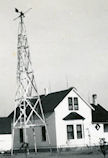 In Sidney, people’s memories had already been tapped for a book on local history. But two volunteers in particular who ran the Cheyenne County Historical Society and Museum added extra details when working with Commission staff. In small communities, these older people often know all the local businesses, families and their homes. And the information, as is found in the record’s Historical Notes field for this image (George and Mabel Jung farm with early wind power from the Cheyenne County Historical Society and Museum collection), can provide insights into the lives and living conditions of people in Nebraska and the Midwest during those earlier times.
In Sidney, people’s memories had already been tapped for a book on local history. But two volunteers in particular who ran the Cheyenne County Historical Society and Museum added extra details when working with Commission staff. In small communities, these older people often know all the local businesses, families and their homes. And the information, as is found in the record’s Historical Notes field for this image (George and Mabel Jung farm with early wind power from the Cheyenne County Historical Society and Museum collection), can provide insights into the lives and living conditions of people in Nebraska and the Midwest during those earlier times.
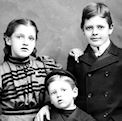 Another volunteer-run project, the Butler County Gallery collection (which consists mostly of studio portraits), used a different approach in tapping people resources. Whenever they heard a family reunion was to be held, they would reach out to promote their collection and ask for information. Feedback included people’s names, birth and death dates, professions and activities, and personal stories. And, of course, corrections! Such was the case with this photograph of Lyle, Fay and Garth Osterhout.
Another volunteer-run project, the Butler County Gallery collection (which consists mostly of studio portraits), used a different approach in tapping people resources. Whenever they heard a family reunion was to be held, they would reach out to promote their collection and ask for information. Feedback included people’s names, birth and death dates, professions and activities, and personal stories. And, of course, corrections! Such was the case with this photograph of Lyle, Fay and Garth Osterhout.
So, if your Nebraska institution has Nebraska-related historical materials that others could enjoy, learn from, or contribute stories to, consider becoming a Nebraska Memories participant. The Nebraska Library Commission hosts the database and will work with your staff on selection of appropriate materials, scanning the items and gathering information to create descriptive records. For more information about participating, see http://nlc.nebraska.gov/nebraskamemories/participation.aspx, or contact Beth Goble, Government Information Services Director, or Devra Dragos, Technology & Access Services Director.
Nebraska Memories is a cooperative project to digitize Nebraska-related historical and cultural heritage materials and make them available to researchers of all ages via the Internet. Visit Nebraska Memories to search for or browse through many more historical images digitized from photographs, negatives, postcards, maps, lantern slides, books and other materials.
Fairs of the past
With the Nebraska State Fair ending earlier this week and many county fairs only distant memories I thought it would be a great time to view some photos of past fairs. As I was looking at the photos of past fairs in Nebraska Memories it’s interesting to see how fairs of the past compare with my current fair memories.
O ne of the items included in Nebraska Memories is a ticket for the fourth annual fair of the Sarpy County Agricultural Society. It was held in Papillion on September 21-24, 1886. As you can see, the ticket is quite fancy with a decorative boarder and a picture of a man and steer printed in red ink. What I find interesting however is the fact that the printed portion of the ticket clearly states it admits the person whose name has been written on the line along with “his wife and children under 18 years of age”. That sure doesn’t look like any fair ticket I’ve ever used.
ne of the items included in Nebraska Memories is a ticket for the fourth annual fair of the Sarpy County Agricultural Society. It was held in Papillion on September 21-24, 1886. As you can see, the ticket is quite fancy with a decorative boarder and a picture of a man and steer printed in red ink. What I find interesting however is the fact that the printed portion of the ticket clearly states it admits the person whose name has been written on the line along with “his wife and children under 18 years of age”. That sure doesn’t look like any fair ticket I’ve ever used.
 Have you ever had your palm read at a fair? This early 1900’s photo shows Madam Seero Temple of Palmistry tent. There is a woman dressed in a costume standing in the entry of the tent who might be Madam Seero herself. Do you think we will ever see a palm reader’s tent at a fair in Nebraska?
Have you ever had your palm read at a fair? This early 1900’s photo shows Madam Seero Temple of Palmistry tent. There is a woman dressed in a costume standing in the entry of the tent who might be Madam Seero herself. Do you think we will ever see a palm reader’s tent at a fair in Nebraska?
 A few things have appeared to stand the test of time. The merry-go-round in this photo from the 1900’s looks a lot like modern-day merry-go-rounds. At a fair this year I saw a number of very nice looking produce exhibits however none of them contained anything as creative as this corn cob log cabin.
A few things have appeared to stand the test of time. The merry-go-round in this photo from the 1900’s looks a lot like modern-day merry-go-rounds. At a fair this year I saw a number of very nice looking produce exhibits however none of them contained anything as creative as this corn cob log cabin.
Take a few minutes and browse the other fair items in Nebraska Memories and think about how fairs of the past compare with your current fair memories.
Visit Nebraska Memories to search for or browse through many more historical images digitized from photographs, negatives, postcards, maps, lantern slides, books and other materials.
Nebraska Memories is a cooperative project to digitize Nebraska-related historical and cultural heritage materials and make them available to researchers of all ages via the Internet. Nebraska Memories is brought to you by the Nebraska Library Commission. If your institution is interested in participating in Nebraska Memories, see http://nlc.nebraska.gov/nebraskamemories/participation.aspx for more information, or contact Beth Goble, Government Information Services Director, or Devra Dragos, Technology & Access Services Director.
Back to School
It’s that time of year again – time to head back to school! Start your school year off right by exploring images of schools and education in Nebraska Memories.
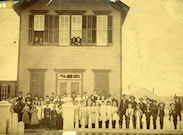 Start by viewing the exteriors of schools through the years. This photograph of a schoolhouse in Sidney was taken in 1887, and it looks very different from this photograph of Bancroft School in Lincoln, taken in the 1950s.
Start by viewing the exteriors of schools through the years. This photograph of a schoolhouse in Sidney was taken in 1887, and it looks very different from this photograph of Bancroft School in Lincoln, taken in the 1950s.
What would school buildings be without the classroom 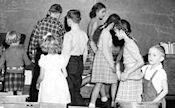 activities inside them? This 1947 classroom at East Olive School in Butler County and this 1924 penmanship class at Bancroft Elementary School in Lincoln are just two examples of Nebraska classrooms.
activities inside them? This 1947 classroom at East Olive School in Butler County and this 1924 penmanship class at Bancroft Elementary School in Lincoln are just two examples of Nebraska classrooms.
 In addition to classes, extracurricular activities are an important part of the school experience. Nebraska schools have had many interesting activities, including a bird lovers’ club at McKinley School in Lincoln and the David City High School men’s quartet.
In addition to classes, extracurricular activities are an important part of the school experience. Nebraska schools have had many interesting activities, including a bird lovers’ club at McKinley School in Lincoln and the David City High School men’s quartet.
Visit Nebraska Memories to search for or browse through many more historical images digitized from photographs, negatives, postcards, maps, lantern slides, books and other materials.
Nebraska Memories is a cooperative project to digitize Nebraska-related historical and cultural heritage materials and make them available to researchers of all ages via the Internet. Nebraska Memories is brought to you by the Nebraska Library Commission. If your institution is interested in participating in Nebraska Memories, see http://nlc.nebraska.gov/nebraskamemories/participation.aspx for more information, or contact Beth Goble, Government Information Services Director, or Devra Dragos, Technology & Access Services Director.
